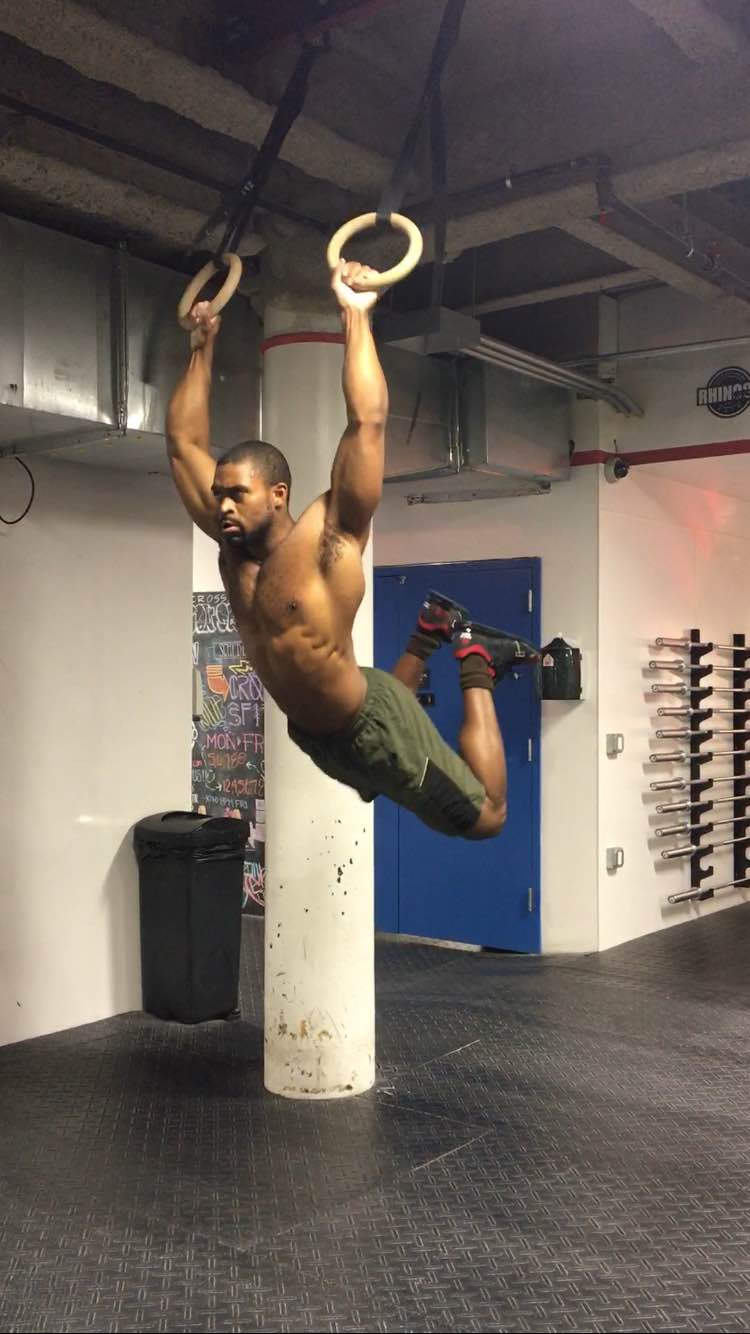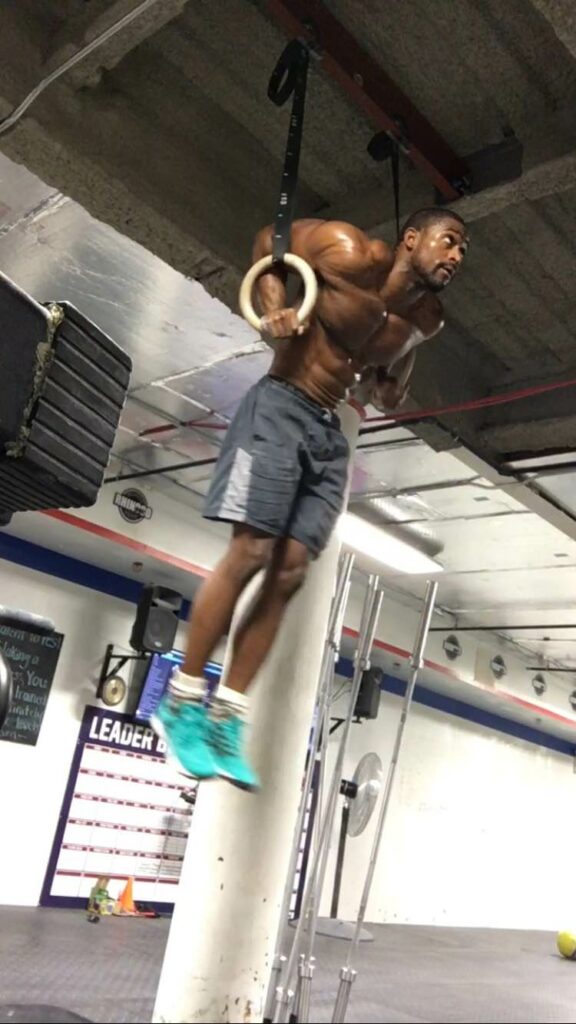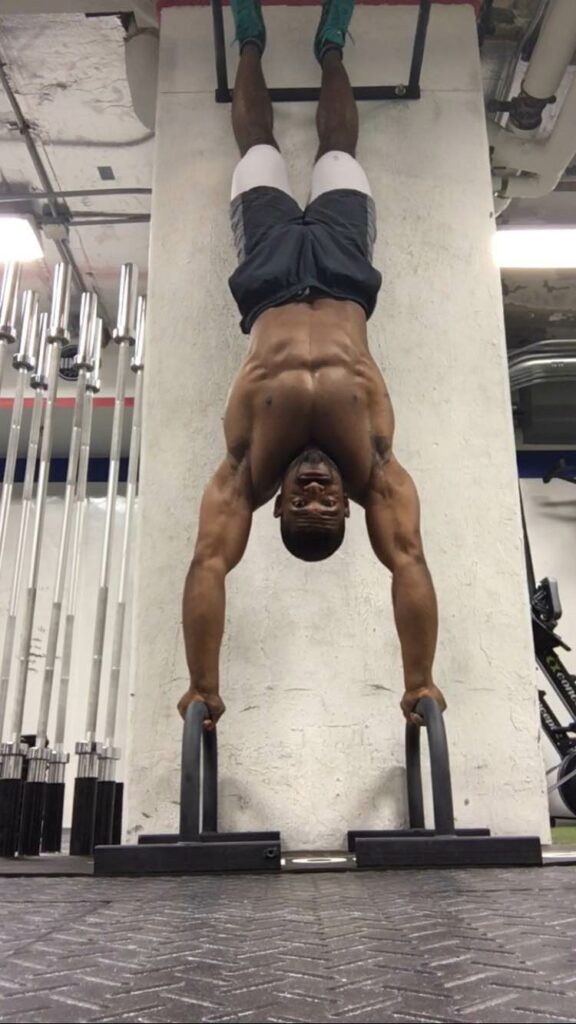The 2016 US Olympic Men’s Gymnastics team didn’t do so hot this year in Rio. But they’re (almost certainly) better at gymnastics than you. And if you’re anything like me (5’10”, 200 lbs), you probably have struggled with some of the more advanced gymnastics movements programmed at your box. Why is that?
Watching these gymnasts on TV, you might say to yourself, “Man these guys are jacked!” And yes, they are pretty ripped! But if you lined up 5’5″ 150 lb Olympian Jake Dalton next to an average NFL kicker at 6’2″ 190 lbs, he’d look tiny. And if you lined him up next to the shortest average position player in the NFL (running back), he’d still look tiny standing next to a 5’11” 215 lb refrigerator shaped mass of man muscle.
But in the sport where jumping, pushing, pulling, flipping, and propelling one’s body are baseline requirements, size is the enemy. I’m not much of an intellectual, but basic math and logic tell me that moving 150 lbs is easier than moving 200 lbs. So how do big guys like us get good at gymnastics?
Get strong. Get stable. Get lean.
Get Strong
If you’re like me, you LOVE to lift heavy. You eat barbells for breakfast. The squat and deadlift are your best friends. And you jump for joy anytime a 1, 2, or 3RM comes up in your program. But a 400 lb squat and 500 lb deadlift won’t necessarily help you string together strict muscle-ups.
Pull-ups, ring dips, toes to bar, handstand push-ups, handstand walking, rope climbs, and muscle-ups all require your arms and shoulders to do the majority of the work. Yes, I know you clean & jerk, snatch, and push press on a daily basis. But all of these movements are initiated by your glutes, hamstrings, and quads.
In order to control your body using mainly arms, you need to get strong in strict pressing and pulling movements. Strict overhead press, bench press, bent-over rows, lat pull downs, and seated rows are all great foundations for gymnastic strength. For example, if you can bench press 1.5x your bodyweight, you can probably do ring dips (a chest dominant movement) with relative ease. And if you can rep out your bodyweight on the lat pulldown machine, you can probably do pull-ups. Now you may be thinking, “I can’t even overhead press my bodyweight for one rep… I’ll never be able to do strict handstand push-ups!” Have no fear!
The handstand push-up is a shorter range of motion than the barbell press. Instead of starting at your shoulders, you start the movement at the top of your head. I weigh 200 lbs, my strict press 1RM is 195 lbs, and I can do 20 strict handstand push-ups unbroken. Note: This is probably one of the only instances in life where it’s advantageous to have a large head!
Unfortunately, there’s not a lot of science out there (yet) on how load and percentages on these movements translate to gymnastic. And different levers and proportions for athletes will add even more variance here.
…But the stronger you are at pushing and pulling barbells, the stronger I’ve found you get at moving your body. If you’re not already on a strength program for your upper body, start one! Focus on strict overhead press, bench press, and barbell bent-over rows for the heavy portion. And supplement with lighter weight and higher volume on accessory movements like chest flys, seated rows, etc. The 5-3-1 program is a very straightforward and easy one to follow.
Aim to incorporate barbell training into your workouts 2-3 times per week. It’s generally best to do your “heavy lifting” at the beginning of any training session to maximize your potential for moving the most load. Gymnastic movements can be trained after the barbell, but you may find that you fatigue faster after lifting. In an ideal world you would rest after your barbell session and return later in the day for gymnastics. But we don’t all have time for that.
So if you need to do both in one session, try balancing pushes with pulls. For example, do heavy strict barbell overhead presses followed by pull-ups on one day. Bent-over rows followed by ring dips on another day, etc.
Get Stable
Do you like doing planks? I don’t. In fact, I hate doing them. I’d rather do 60 GHD sit-ups than hold a plank for 60 seconds. Even though the former task takes about twice the time to complete, the latter is just so…boring! I like to pick things up and put them down. I like to run hard and fast. I like to move it, move it!
But if you want to get good at gymnastics, you have to slow down and statically hold your body for “long” periods of time. Why?
Let’s go back to our boy Jake Dalton for an example. The Still Rings event doesn’t have a prescribed time, but most gymnasts hang between 60-120 seconds. When’s the last time you just held onto a pull-up bar for 2 minutes? That’s not an easy feat for any guy above 175 lbs. Now imagine holding on for 2 minutes while doing strict toes to bar and muscle-ups. Not gonna happen for most of us! But the principle here is that you need to be able to control your body isometrically to excel at gymnastics.
Think about the muscle-up. A lot of big, strong guys can do pull-ups and ring dips, but for some reason can’t get a single muscle-up. Why is that? Technique is one reason obviously. But what about the catch (the part where you transition from the pull-up to the dip)? The muscle-up catch requires a great deal of isometric control. And for most people who are on the border of getting their first muscle-up (or who are inconsistent in performing the movement), a lack of stability and control is the cause. To master the muscle-up, you need to spend time on the low rings to build stability and isometric strength.
Try this: keeping your elbows as close to your body as possible, lower yourself to the bottom position on the low rings so that your biceps are touching the top of the rings. You should feel your chest and triceps fighting to stay in position. Keep the rest of your body as tight as possible. Hold here for 20 seconds. Rest 1 minute. Then repeat for a total of 4-8 rounds. If this is easy for you, decrease your rest time. If you can do 8 rounds of 20 seconds on, 20 seconds off, your stability and isometric strength are good. If this is hard for you, decrease the working intervals to a time that you can hold (5-10 seconds).
Repeat this process 2-3 times per week and try to add 1 second to your hold time with each passing week until you work your way up to 20 seconds. This may sound easy on paper, but I promise you will feel muscles working in your chest, shoulders, and triceps that you didn’t even know you had!
Similar strategies can be applied to handstand push-ups. If you can’t do HSPU yet, start by kicking up to the wall and holding yourself in an isometric handstand with elbows locked out for 20-30 seconds. As this becomes easy, increase hold times and decrease rest intervals. Then as this becomes easy, start working on slow eccentric handstand push-ups. Starting in a handstand, slowly lower your head to the floor. Think a slow 3-5 Mississippi count. Strengthening your shoulders and triceps isometrically and eccentrically will help you build the strength for the concentric movement (the actual push-up portion).
Planks, hollow rocks, and static L holds will also help your gymnastics ability. Your arms do most of the heavy lifting in gymnastics, but a strong and stable midline will help control the rest of your body throughout movements. Add these movements into your program 2-3 times per week as a buyout (end of workout). Aim for 30-60 seconds of holds for 4-8 sets.
Get Lean
If I asked you how much Jake Dalton weighed before reading this article, what would you guess? Based on his biceps, shoulders, overall muscular definition, and low camera angles, you might think upwards of 175 lbs. Even though he’s “small” he looks big because the majority of his body is muscle. Elite level male gymnasts generally range from 5-10% body fat. Though his body fat is not publicly listed, I assume Jake is easily within that range based on my experience measuring hundreds of clients’ and athletes’ body fat throughout my career as a trainer.
So excluding bones, blood, internal organs, and skin, a great deal of his body can make muscular contractions to help him lift, flip, pull and press. Compare that to a 200 lb guy with 20% body fat. That guy is lugging around a lot more “excess baggage” that does nothing but make pull-ups harder!
To put things into perspective, most males with visible abs have 10% body fat or lower. For females the equivalent is about 18%. I weigh 200 lbs and I vacillate between 6-8% depending on the time of year. And I attribute a lot of my gymnastic abilities to my body composition. So how do you get lean without losing strength?
I’m sure you’re sick of hearing the phrase “abs are made in the kitchen,” but it’s absolutely true. Throughout my personal training/coaching career I’ve worked with clients and members from a wide range of athletic backgrounds, body compositions, and fitness goals. Regardless of training frequency, the people that have the greatest success in reaching their goals are those who have made a commitment to eating clean.
For example, in my LA Fitness days I trained an obese woman (let’s call her Pam) five times per week. We did a combination of cardio, strength training, and basic bodyweight movements. She lost zero pounds during our first month together. Why? Aside from late cancelling on me 40-60% of the time, she changed nothing about her diet. In fact, she would eat more on days that we trained because she ignorantly thought she “could eat whatever she wanted because she worked out that day.”
Compare Pam to my client (let’s call him Brian) who only trained with me 3-4 times per month. He went from a 205 lbs and 33% body fat to 195 lbs and 16% body fat during our first year together. How? He didn’t do a crazy no carb diet or an overly complicated macronutrient based plan. He ate whole foods (with lots of protein), cut out junk food, controlled his portions, and had one cheat meal per week. In short, he didn’t eat like an asshole. And that’s the biggest piece of advice I give my my clients and athletes. Eat real food (i.e. food that comes from a plant or animal). Drink lots of water. Eat to fuel your workouts and daily activity. And eat until you’re full, not until you’re uncomfortable.
In Summation
Be patient with the process! As you get stronger, more stable, and closer to that lean, mean body composition, the easier it will be to lift, pull, and press your body! Just like weightlifting, most people who have any proficiency at gymnastics have been training in the sport for years — sometimes liftetimes. It can be utterly frustrating at times, but when you can string together more and more muscle-ups than ever before, it will seem worth every second!
Editors note: This article is an op-ed. The views expressed herein are the authors and don’t necessarily reflect the views of BarBend. Claims, assertions, opinions, and quotes have been sourced exclusively by the author.


